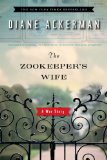Summary | Excerpt | Reading Guide | Reviews | Beyond the Book | Readalikes | Genres & Themes | Author Bio

A War Story
by Diane Ackerman
Only prehistoric creatures would do, ones untainted by racial mixing, and
although Lutz hoped to gain influence and fame in the process, his motives were
more personal—he sought the thrill of bringing extinct, nearly magical animals
back to life and steering their fate, hunting some for sport. Genetic
engineering wouldn’t emerge until the 1970s, but he decided to use eugenics, a
traditional method of breeding animals which showed specific traits. Heck’s
reasoning went like this: an animal inherits 50 percent of its genes from each
parent, and even an extinct animal’s genes remain in the living gene pool, so if
he concentrated the genes by breeding together animals that most resembled an
extinct one, in time he would arrive at their purebred ancestor. The war gave
him the excuse to loot east European zoos and wilds for the best specimens.
As it happens, the animals he chose all thrived in Poland, their historic
landscape was Bial/owiezÿa, and the imprimatur of a respected Polish zoo would
legitimize his efforts. When Germany invaded Poland, Heck scouted the farms for
mares preserving the most tarpan traits to mate them with several wild strains,
including Shetlands, Arabians, and Przywalskis, hoping to breed back to the
ideal animal, the fierce, nearly unridable horses painted in ochre on Cro-Magnon
caves. Heck assumed it wouldn’t take many generations of back-breeding—maybe
only six or eight—because as recently as the 1700s tarpans still roamed the
forests of northeastern Poland.
During the Ice Ages, when glaciers blanketed northern Europe and a wind-ripped
tundra stretched down to the Mediterranean countryside, thick forests and
fertile meadows gave refuge to great herds of tarpans that roamed the central
European lowlands, browsed the east European steppes, and galloped across Asia
and the Americas. In the fifth century b.c., Herodotus said how much he enjoyed
watching herds of tarpans grazing in the bogs and marshes of what is now Poland.
For ages, purebred tarpans outwitted all the hunters and somehow survived in
Europe, but by the eighteenth century not many remained, in part because diners
prized tarpan meat—it was sweet, but more appealingly, it was rare—and in part
because most tarpans had interbred with farm horses to produce fertile
offspring. In 1880, pursued by humans, the last wild tarpan mare fell down a
crevasse in Ukraine and died; and the last captive tarpan died seven years later
in the Munich Zoo. At that point the species officially became extinct, just one
more chapter in the annals of life on Earth.
Humans domesticated wild horses about six thousand years ago, and immediately
began refining them: killing the defiant ones for food while breeding the most
genial, to produce a horse that submits more easily to saddle and plow. In the
process, we revised the horse ’s nature, compelling it to shed its zesty,
ungovernable, evasive wildness. The aloof, free-range Przywalski horses retained
that fury, and Heck planned to weave their combative spirit into the new
tarpan’s genetic mix. History credits Colonel Nikolai Przywalski, a Russian
explorer of Polish descent, with "discovering" the wild Asiatic horse in 1879,
hence its name, though, of course, the horse was well known to the Mongolians,
who had already named it tahki. Heck factored the tahki’s stamina, temper, and
looks into his formula, but he craved even older creatures—the horses that
dominated the prehistoric world.
What a powerful ideal—that sexy, high-strung horse, pawing the ground in
defiance, its hooves all declaratives. Heinz Heck wrote after the war that he
and his brother had begun the back-breeding project out of curiosity, but also
from "the thought that if man cannot be halted in his mad destruction of himself
and other creatures, it is at least a consolation if some of those kinds of
animals he has already exterminated can be brought back to life again." But why
have tarpans to ride if there were nothing worthy to hunt?
Reprinted from The Zookeeper's Wife by Diane Ackerman. Copyright (c) 2007 by Diane Ackerman. With permission of the publisher, W.W. Norton & Company, Inc.
Your guide toexceptional books
BookBrowse seeks out and recommends the best in contemporary fiction and nonfiction—books that not only engage and entertain but also deepen our understanding of ourselves and the world around us.